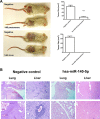Inhibition of colorectal cancer stem cell survival and invasive potential by hsa-miR-140-5p mediated suppression of Smad2 and autophagy
- PMID: 25980495
- PMCID: PMC4637317
- DOI: 10.18632/oncotarget.3771
Inhibition of colorectal cancer stem cell survival and invasive potential by hsa-miR-140-5p mediated suppression of Smad2 and autophagy
Abstract
Colorectal cancer (CRC) is the third highest mortality cancer in the United States and frequently metastasizes to liver and lung. Smad2 is a key element downstream of the TGF-β signaling pathway to regulate cancer metastasis by promoting epithelial to mesenchymal transition and maintaining the cancer stem cell (CSC) phenotype. In this study, we show that hsa-miR-140-5p directly targets Smad2 and overexpression of hsa-miR-140-5p in CRC cell lines decreases Smad2 expression levels, leading decreased cell invasion and proliferation, and increasing cell cycle arrest. Ectopic expression of hsa-miR-140-5p in colorectal CSCs inhibited CSC growth and sphere formation in vitro by disrupting autophagy. We have systematically identified targets of hsa-miR-140-5p involved in autophagy. Furthermore, overexpression of hsa-miR-140-5p in CSCs abolished tumor formation and metastasis in vivo. In addition, there is a progressive loss of hsa-miR-140-5p expression from normal colorectal mucosa to primary tumor tissues, with further reduction in liver metastatic tissues. Higher hsa-miR-140 expression is significantly correlated with better survival in stage III and IV colorectal cancer patients.The functional and clinical significance of hsa-miR-140-5p suggests that it is a key regulator in CRC progression and metastasis, and may have potential as a novel therapeutic molecule to treat CRC.
Keywords: Smad2; autophagy; colon cancer stem cell; hsa-miR-140-5p; metastasis.
Figures







Similar articles
-
MiR-338-5p promotes metastasis of colorectal cancer by inhibition of phosphatidylinositol 3-kinase, catalytic subunit type 3-mediated autophagy pathway.EBioMedicine. 2019 May;43:270-281. doi: 10.1016/j.ebiom.2019.04.010. Epub 2019 Apr 12. EBioMedicine. 2019. PMID: 30982765 Free PMC article.
-
Down-regulation of KIAA1199/CEMIP by miR-216a suppresses tumor invasion and metastasis in colorectal cancer.Int J Cancer. 2017 May 15;140(10):2298-2309. doi: 10.1002/ijc.30656. Epub 2017 Mar 2. Int J Cancer. 2017. PMID: 28213952
-
The SOX17/miR-371-5p/SOX2 axis inhibits EMT, stem cell properties and metastasis in colorectal cancer.Oncotarget. 2015 Apr 20;6(11):9099-112. doi: 10.18632/oncotarget.3603. Oncotarget. 2015. PMID: 25868860 Free PMC article.
-
Non-coding RNAs Functioning in Colorectal Cancer Stem Cells.Adv Exp Med Biol. 2016;937:93-108. doi: 10.1007/978-3-319-42059-2_5. Adv Exp Med Biol. 2016. PMID: 27573896 Review.
-
The Roles of Cancer Stem Cells and Therapy Resistance in Colorectal Carcinoma.Cells. 2020 Jun 3;9(6):1392. doi: 10.3390/cells9061392. Cells. 2020. PMID: 32503256 Free PMC article. Review.
Cited by
-
Prognostic value of microRNAs in colorectal cancer: a meta-analysis.Cancer Manag Res. 2018 Apr 30;10:907-929. doi: 10.2147/CMAR.S157493. eCollection 2018. Cancer Manag Res. 2018. PMID: 29750053 Free PMC article.
-
MicroRNA-140 Inhibits the Epithelial-Mesenchymal Transition and Metastasis in Colorectal Cancer.Mol Ther Nucleic Acids. 2018 Mar 2;10:426-437. doi: 10.1016/j.omtn.2017.12.022. Epub 2018 Jan 4. Mol Ther Nucleic Acids. 2018. Retraction in: Mol Ther Nucleic Acids. 2022 Nov 05;30:353. doi: 10.1016/j.omtn.2022.10.018. PMID: 29499953 Free PMC article. Retracted.
-
Roles of microRNAs in Gastrointestinal Cancer Stem Cell Resistance and Therapeutic Development.Int J Mol Sci. 2021 Feb 5;22(4):1624. doi: 10.3390/ijms22041624. Int J Mol Sci. 2021. PMID: 33562727 Free PMC article. Review.
-
Prognostic role of microRNAs in human gastrointestinal cancer: A systematic review and meta-analysis.Oncotarget. 2017 Jul 11;8(28):46611-46623. doi: 10.18632/oncotarget.16679. Oncotarget. 2017. PMID: 28402940 Free PMC article.
-
The Roles of Autophagy-related miRNAs in Gynecologic Tumors: A Review of Current Knowledge for Possible Targeted Therapy.Curr Mol Med. 2024;24(10):1269-1281. doi: 10.2174/0115665240263059231002093454. Curr Mol Med. 2024. PMID: 39300715 Review.
References
-
- Alwan A. World Health Organization. Disaster Med Public Health Prep. 2007;1:7–8. - PubMed
-
- Hegde SR, Sun W, Lynch JP. Systemic and targeted therapy for advanced colon cancer. Expert Rev Gastroenterol Hepatol. 2008;2:135–49. - PubMed
-
- Fang SH, Guidroz JA, O'Malley Y, Lal G, Sugg SL, Howe JR, Jensen CS, Weigel RJ. Expansion of a cell population expressing stem cell markers in parathyroid glands from patients with hyperparathyroidism. Ann Surg. 2010;251:107–13. - PubMed
-
- O'Brien CA, Pollett A, Gallinger S, Dick JE. A human colon cancer cell capable of initiating tumour growth in immunodeficient mice. Nature. 2007;445:106–10. - PubMed
-
- Ricci-Vitiani L, Lombardi DG, Pilozzi E, Biffoni M, Todaro M, Peschle C, De Maria R. Identification and expansion of human colon-cancer-initiating cells. Nature. 2007;445:111–5. - PubMed
Publication types
MeSH terms
Substances
Grants and funding
LinkOut - more resources
Full Text Sources
Other Literature Sources
Medical

